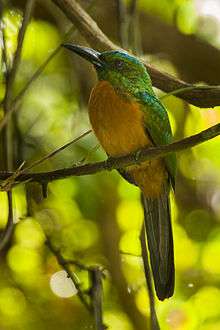Great jacamar
| Great jacamar | |
|---|---|
 | |
| Scientific classification | |
| Kingdom: | Animalia |
| Phylum: | Chordata |
| Class: | Aves |
| Order: | Piciformes |
| Family: | Galbulidae |
| Genus: | Jacamerops Lesson, 1830 |
| Species: | J. aureus |
| Binomial name | |
| Jacamerops aureus (Statius Müller, 1776) | |
The great jacamar (Jacamerops aureus) is a species of bird in the family Galbulidae. It is placed in the monotypic genus Jacamerops.[2] It is found in Bolivia, Brazil, Colombia, Costa Rica, Ecuador, French Guiana, Guyana, Panama, Peru, Suriname, and Venezuela, where its natural habitat is subtropical and tropical moist lowland forests.[1]
Taxonomy
German zoologist Philipp Ludwig Statius Müller described the species in 1776. The species name is the Latin adjective aureus "golden". In 2000, the binomial name was changed from J. aurea to J. aureus so the species name agreed in gender with the genus name.[3]
Description
It measures 29.5 to 30 cm (11.61 to 11.81 in) in length and weighs between 63 and 70 g (2.22 and 2.47 oz) . The adult male chin, cheeks and upper region are all bright metallic green with gold overtones, with a blueish tinge on the chin, forehead and tail and purple copper on the back. The lower part of the throat is white and the rest of the lower region is deep rufous. The primaries are black, the tail is blue-black, below the beak is black, and the legs are dark horn-colored. The female resembles the male, but has no white spot on the throat. Like all members of the order Piciformes, jacamars and their relatives have zygodactyl feet, with two toes pointing forward and two facing back. Jacamars evolved with this toe arrangement, which helps them grasp branches while hunting in trees.[4] Because 13 of the 17 Galbulidae species belong to super-species complexes, researcher J. Haffer concludes that jacamars had a relatively recent Pleistocene radiation of the family. Jacamars are believed to have originated in the Amazon region where they are most common, and spread to other parts of Central and South America. Unique anatomical features of this family include a long appendix, no gall bladder, a bare preen gland, and a long, thin tongue.[5]
Habitat
Its natural habitat is the natural tropical forest to 500 m (1,640 ft) altitude. It lives in the middle levels of the canopy and inside the shaded edges of the rainforest,[6] usually on the banks of streams. It can be difficult to spot because it is noted for sitting in one spot for a long period of time.
Food
It feeds on insects caught in flight, and on spiders on vegetation.[7] While sitting in its canopy, they prey by following after them, and then by beating them against a branch before they consume it. Some of the jacamars will also eat small vertebrates like lizards.[8]
Reproduction
It breeds from March to May or June. Its nest is a chamber made of a termite tree, at a height between 3 and 15 m (10 and 49 ft).[6] These birds will burr holes in arboreal termitaria 3-15 meter above ground.[8] The incubation time for the great jacamars is about 20–23 days. The baby chicks come out from their nest around 21–26 days; When they emerge they are covered in white down. Both male and female jacamars incubate and will care for their baby chicks.[8] Jacamars lay one to four round, glossy, white eggs. Both parents incubate the eggs during the day for one to three hours at a time. At night, the female incubates alone while the male stays nearby to defend the nest. Jacamars rarely leave eggs unattended.[5]
Conservation
This species has an extremely large range, and does not approach the title for Vulnerable under the range size criterion (Extent of Occurrence <20,000 km2 combined with a declining or fluctuating range size, habitat extent/quality, or population size and a small number of locations or severe fragmentation).[9] Even though the population shows to be decreasing, the decline is not presumed to be able to get the title for Vulnerable under the population trend criterion (>30% decline over ten years or three generations).[8] The population size has not been calculated, but it is not believed to reach the namesake for Vulnerable under the population size criterion (<10,000 mature individuals with a continuing decline estimated to be >10% in ten years or three generations, or with a specified population structure).[10] For the reasons listed above the species is labeled as Least Concern.
References
- 1 2 BirdLife International (2012). "Jacamerops aureus". IUCN Red List of Threatened Species. Version 2013.2. International Union for Conservation of Nature. Retrieved 26 November 2013.
- ↑ "ITIS Report: Jacamerops". Integrated Taxonomic Information System. Retrieved 15 August 2014.
- ↑ Banks, Richard C.; Cicero, Carla; Dunn, Jon L.; Kratter, Andrew W.; Ouellet, Henri; Rasmussen, Pamela C.; Remsen, Jr., J. V.; Rising, James A.; Stotz, Douglas F. (2000). "Forty-Second Supplement to the American Ornithologists' Union Check-List of North American Birds" (PDF). The Auk. 117 (3): 847–58.
- ↑ "Jacamars (Galbulidae)". Encyclopedia. Retrieved 19 March 2018.
- 1 2 "Jacamars (Galbulidae)". Encyclopedia.com. Retrieved 19 March 2018.
- 1 2 Jacamerops aureus (Muller, 1776) (Jacamar grande) Archived 2013-11-10 at the Wayback Machine.; Especies de Costa Rica. INBio.
- ↑ Schulenberg, T. S. "Great Jacamar". The Cornell Lab of Ornithology Neotropical Birds. Neotropical Birds Online. Retrieved 19 March 2018.
- 1 2 3 4 "Great Jacamar (Jacamerops aurea)". Planet of Birds. Retrieved 19 March 2018.
- ↑ "Great Jacamar (Jacamerops aurea)". Planet of Birds. Retrieved 15 March 2018.
- ↑ "Great Jacamar (Jacamerops aurea)". Planet of Birds. Retrieved 27 February 2018.
